There are 18 salamanders in New York. Some popular salamanders endemic to New York include red salamanders, redback, dusky salamanders, and mudpuppies.
A lot of the more popular ones can be kept as pets. If you decide to keep a salamander as a pet, it is essential to know that it’s a display pet. Since they have delicate skins, handling them is not advisable.
Salamanders may resemble lizards or even eels but they are amphibians and not reptiles or fishes. Salamanders start off as larvae. They then develop into efts (if they are newts). Finally, they develop into adults. Most salamanders undergo this metamorphosis where they change from aquatic creatures to terrestrial ones.
Table of Contents
Salamanders in New York
Family Ambystomatidae
1. Jefferson Salamander
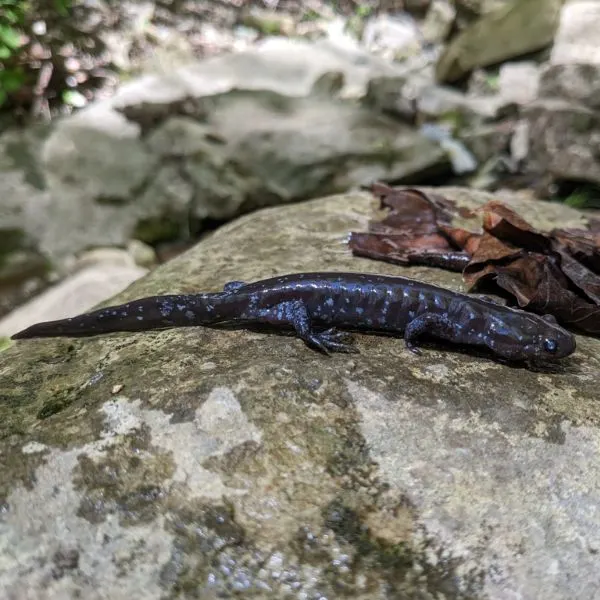
- Binomial Nomenclature: Ambystoma jeffersonianum
- Adult Length: 10.7 to 21 cm (4.2 to 8.3 inches)
- Population Trend: Stable
- Conservation Statuses: Least Concern on IUCN, S4 (Apparently Secure)
In New York, the species is endemic to the southeast. It is endemic from southeastern New York through Pennsylvania and Ohio to southern Indiana. The species’ range extends to northern Virginia and southcentral Kentucky. The species is also endemic to Ontario.
Ambystoma jeffersonianum is dark brown to gray in color with light blue speckles on the sides and tail. These speckles disappear with age. The species is relatively large and can reach a length of about 8 inches.
2. Blue-spotted Salamander
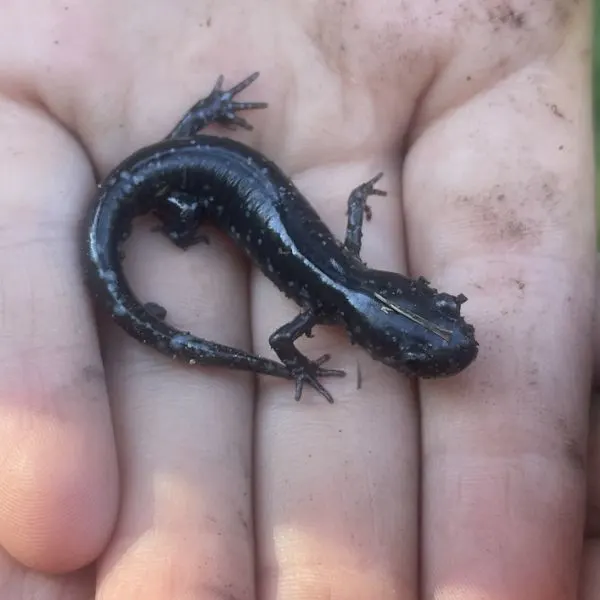
- Binomial Nomenclature: Ambystoma laterale
- Adult Length: 10 to 14 cm
- Population Trend: Stable
- Conservation Statuses: Least Concern on IUCN, S3 (Vulnerable)
This species is endemic to northeastern North America. Its geographic range includes several provinces in the United States and several states in the United States. The species is endemic to most of New York. The species hybridize with the Jefferson salamander and most of the species found are hybrids.
Outside of New York, disjunct wild populations exist in Nova Scotia and the periphery of its geographic range. Ambystoma laterale occurs in New Jersey and northern Indiana to New England and farther north through the great lakes to Lake Winnipeg and Southern Québec.
This species is bluish-black. The underside is also bluish-black but may be lighter in coloration. About 40% of the amphibian’s total body length is the tail.
3. Spotted Salamander
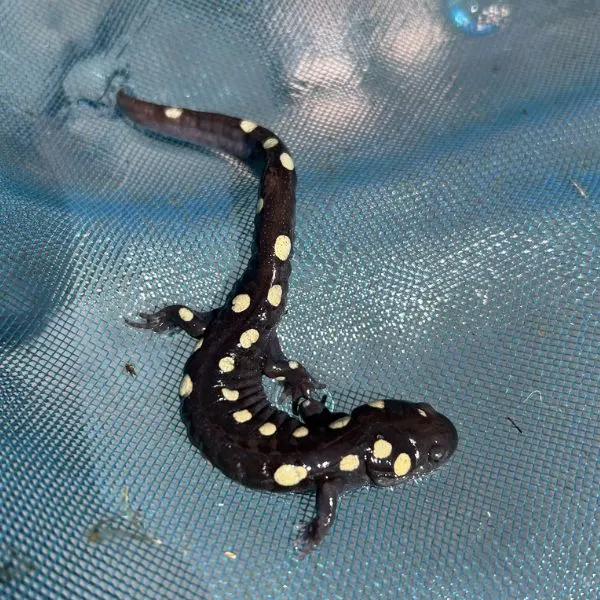
- Binomial Nomenclature: Ambystoma maculatum
- Adult Length: 5.91 to 9.84 inches (15 to 25 cm)
- Adult Size: 0.45 oz (12.84 g)
- Life Span: 20 to 30 years
- Population Trend: Stable
- Conservation Statuses: S5 (Secure), Least Concern on IUCN
This species is endemic to most of eastern North America. Within the United States, the species is endemic to provinces in the east including Ontario, Québec, New Brunswick, nova scotia, and Prince Edward Island.
In the United States, the species is endemic to most of the eastern United States, from Texas to south carolina up north to Maine. In the northeastern United States, the species’ geographic range extends as far east as Minnesota.
This species occurs in mixed forests and hardwood forests in and around vernal pools and swaps. Adults can be found in burrows such as mammal burrows and under objects such as stumps and logs.
This is a large amphibian that reaches a length of 6 to 10 inches. The upper body of the amphibian is black, dark gray, or brown with yellow spots that run down the sides. These spots give the species its common name.
The species can live to be 30, although they typically have a lifespan of 20 years.
4. Marbled Salamander
- Binomial Nomenclature: Ambystoma opacum
- Average Adult Size: 3.5 to 4.2 inches
- Average Life Span: 3.5 to 4 years
- Population Trend: Stable
- Conservation Statuses: Least Concern on IUCN, S3 (Vulnerable)
The species occurs in southeastern New York. Outside of New York, the range extends from southern New Hampshire to Florida. It also extends to Lake Michigan to Oklahoma and finally to eastern Texas and the Gulf Coast. The species doesn’t occur in most of the Appalachians.
This species is always within 300 m of a breeding pond. The species is always found near breeding pools and swamps within woodlands. Unlike most other salamanders, Ambystoma opacum can also live comfortably in drier biomes and has been sighted in wooded sand dunes, slopes, and rocky bluffs.
Larvae of the species are aquatic while adults are terrestrial. Larvae live in slow-moving streams, swamps, and permanent ponds. While adults can be found under debris such as logs and underground in burrows.
Within the family Ambystomatidae, the marbled salamander is tiny. An adult marbled salamander reaches a length of 3.5 inches to 4.2 inches. This salamander has crossbands of white and black across the entire body.
The average lifespan in captivity is 3.5 to 4 years.
5. Eastern Tiger Salamander
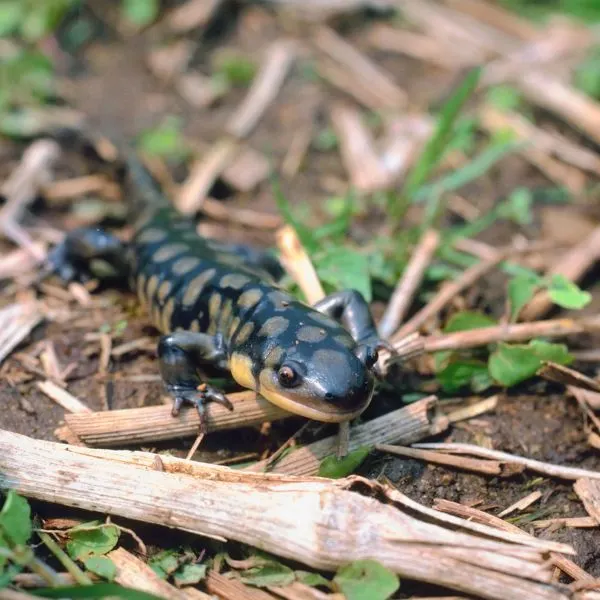
- Binomial Nomenclature: Ambystoma tigrinum
- Other Common Names: Tiger salamander
- Adult Length: 7 to 13 inches (17 to 33 cm)
- Life Span: 16 to 25 years
- Population Trend: Stable
- Conservation Statuses: Least Concern on IUCN, S5 (Secure)
In New York, adults can be found in wooded areas, they however avoid grassy areas. Adults generally live underground and can be found in burrows they make themselves or the burrows of shrews, rodents, and other mammals. Also, in New York, the species are generally within 300 m of a breeding pond.
The species usually migrate when it rains. The species prefer high humidity and will burrow underground to find a humid environment. They also come out when humidity levels are high such as during rainfall.
The species is found across North America from New York to Oregon. They also occur in Ontario and Manitoba. The species is also native as far south as Texas and Florida.
This is a large salamander that can reach a length of over 1 foot. It is also thick-bodied. This salamander is also kept as a pet. It gets the tiger in its common name from the yellow and black coloration of the skin. The specie has 12 to 13 costal grooves.
Aquatic adults live to be 25 years and terrestrial adults live to be 16 years. The aquatic adults are those that remain in larval form, while the terrestrial adults are the ones that undergo metamorphosis.
Family Plethodontidae
6. Northern Dusky Salamander
- Binomial Nomenclature: Desmognathus fuscus
- Adult Size: 2.5 to 5.6 inches (6.4 to 14.2 cm)
- Population Trend: Stable
- Conservation Statuses: Least Concern on IUCN, S5 (Secure)
The species is endemic to most of the eastern United States and the eastern United States. The species is abundant within its geographic range. The species is endemic to southern Ontario, southeastern Québec, and southern new Brunswick. In the United States, the range continues to southeastern Indiana, Kentucky, Tennessee, and Georgia.
The species occur in mucky parts of upland streams in the southern portion of its geographic range. It is also found in sloughs and floodplains in the southern portion of its geographic range. Within the northern portion of its range, the species occur in springs, seepages, and rock-strewn streams found in wooded areas.
This salamander is considered small and robust. It has 14 costal grooves. The dorsum is reddish to brownies or even gray. The underside is white.
7. Allegheny Mountain Dusky Salamander
- Binomial Nomenclature: Desmognathus ochrophaeus
- Adult Length: 2.8 to 4 inches (7 to 10 cm)
- Life Span: 5.3 years
- Population Trend: Stable
- Conservation Statuses: S5 (Secure), Least Concern on IUCN
The species is endemic to eastern North America. It is endemic to Québec and Ontario in the United States; and New York, New Jersey, Pennsylvania, Virginia, West Virginia, Tennessee, Ohio, Maryland, and Kentucky in the United States. In New York, the species is found throughout the Adirondack Mountains. It is also common in the Allegheny Mountains and Plateau where it gets its common name from.
The species is endemic to wooded areas when the weather is humid. They are also endemic to small streams, springs, and seepage areas during the winter and at low elevations. Within higher elevations, adults are known to inhabit spruce-fir forests. Another place where they are commonly found is on wet rock faces.
The species is moderately sized. Males are longer than females and have brighter coloration. The species come in different colors and patterns.
The average lifespan of the species in captivity is 5.3 years. There isn’t information on the lifespan in the wild.
8. Northern Two-lined Salamander
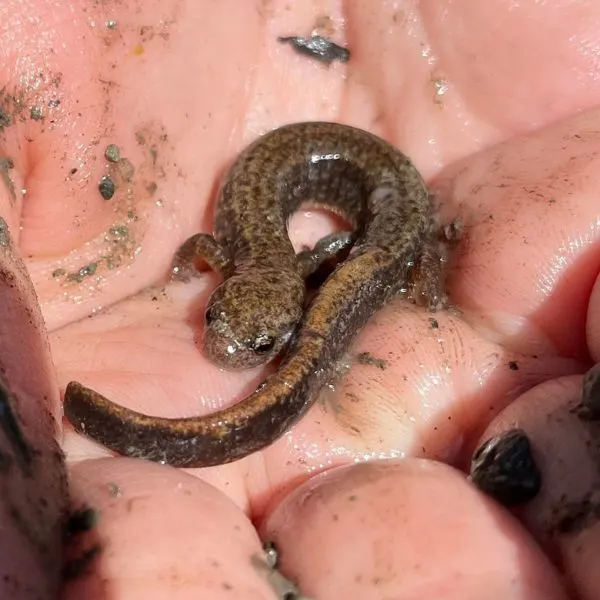
- Taxonomic Name: Eurycea bislineata
- Adult Body Length: 2.5 to 4.8 inches (6.4 to 12.1 cm)
- Population Trend: Stable
- Conservation Statuses: S2S3 (Imperiled), Least Concern IUCN
In New York, the species have been witnessed in acidic fishless lakes. Here they can occur at depths of 19.5 m. in New York, they aren’t usually found on soil with low pH. The species inhabit woodlands during warm wet weather and are found in and around seepages, springs, and rocky brooks. They are known to live under objects such as leaf litter and logs close to their vernal ponds.
Outside of New York, the species’ geographic range includes eastern Ontario, southern Québec to northern Virginia, central Ohio, and eastern West Virginia. They can also be found in Labrador, another province in the United States.
The northern two-lined salamander has two lines on its back. These lines start from the eye to the tip of the tail and give the amphibian its common name. The color of the species is yellowish to greenish-yellow.
9. Longtail Salamander

- Binomial Nomenclature: Eurycea longicauda
- Other Common Names: eastern long-tailed salamander
- Average Adult Size: 4 to 8 inches (10 to 20 cm)
- Life Span: 5 to 10 years
- Population Trend: Stable
- Conservation Statuses: Least Concern on IUCN, S2S3 (Imperiled)
The species is endemic to southern New York. Outside of New York, the range extends to Missouri, northwestern Virginia, western North Carolina, northwestern Georgia, northern Alabama, northern Mississippi, and Tennessee.
The species live in woodlands. Here adults hide under logs, rocks, and in crevices of rocky terrain. The larvae live in streams, ponds, and springs. The adults lay the eggs when these water bodies are dried up.
The longtail salamander is a moderately sized salamander with a long tail that makes up about 60% of its entire body length. The salamander is yellow to red in color with a cream or light yellow ventrum or underside.
The species have a lifespan of 5 to 10 years in the wild.
10. Spring Salamander

- Binomial Nomenclature: Gyrinophilus porphyriticus
- Adult Length: 4.7 to 7.5 inches (12 to 19 cm)
- Life Span: 18.5 years in captivity
- Population Trend: Stable
- Conservation Statuses: Least Concern on IUCN, S5 (Secure)
The species is endemic from southern Québec to northern Mississippi, Alabama, and Georgia. It is found in several states along the way such as Maine, Maryland, New York, North Carolina, and several others.
The species is endemic to shaded seepages, caves, clear springs, small clear upland streams, swamps, and lake margins. They are also endemic in wet woodlands during the rainy season. Apart from those times, they are always in around streams and other water bodies. Adults can be found under leaves, logs, rocks, and moss near or in water.
The amphibian lay eggs under rocks in streams and springs. The larvae then live in these water bodies until they metamorphose.
As with other salamanders, the specie is a carnivore, to be specific an invertivore, as it feeds mainly on small invertebrates. It also feeds on small amphibians.
This is a moderately sized salamander that can reach a length of 7.5 inches. The range length of the species is 4.7 to 7.5 inches. The spring salamander is reddish. The coloration ranges from light brownish to yellow. There are black spots on the dorsum.
The species have a lifespan of 18.5 years in captivity. Nothing is known about the lifespan in the wild.
11. Four-toed Salamander
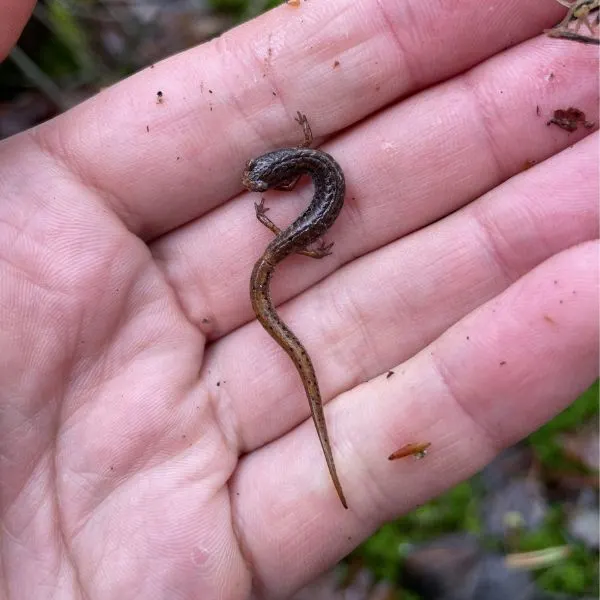
- Binomial Nomenclature: Hemidactylium scutatum
- Average Adult Size: 2 to 4 inches (5.1 to 10.2 cm)
- Life Span: 5.5 years
- Population Trend: Stable
- Conservation Statuses: Least Concern on IUCN Red List, S4 (Apparently Secure)
The four-toed salamander has four toes on its hind legs. This characteristic gives it its common name. The species is quite widely distributed in New York. The distribution of the species overall is discontinuous. The species occur in nova scotia, southern Québeck, New Brunswick, and southern Ontario in the United States.
In the United States, the species is endemic to most of the eastern United States, from Maine to Minnesota westwards, and to Florida in the south. The geographic range also extends to Oklahoma.
The species is endemic to wet woodlands as well as open areas such as prairies close to water bodies such as ponds, sedgy pools, boggy streams, and swamps. There is usually an abundance of sphagnum moss within its habitat.
The species lay eggs above or next to pools where the larvae live after hatching.
The species eat small aquatic invertebrates as larvae and small terrestrial invertebrates as adults. They are invertivores.
This salamander is tiny and reaches a length of 4 inches at most. An adult of the species reaches a length of 2 to 4 inches with the tail making up about 60% of its body length. The coloration of this amphibian is brown with black spots. The species have 13 to 14 costal grooves.
According to Max Planck Institute for Demographic Research, the average lifespan of the species is 5.5 years.
12. Eastern Red-Backed Salamander
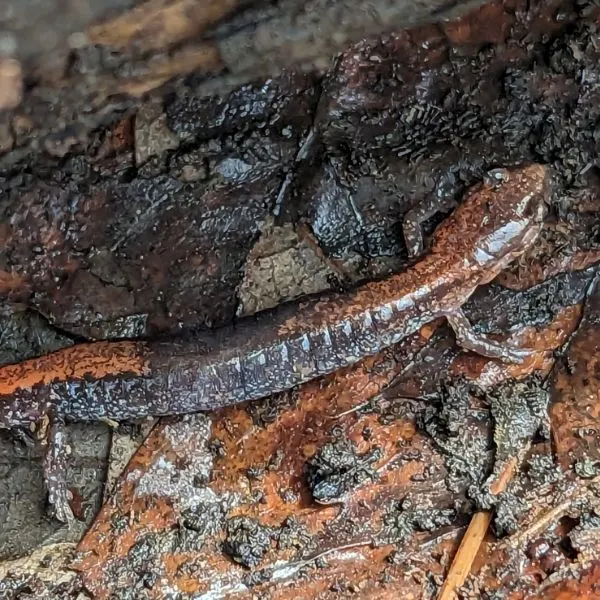
- Binomial Nomenclature: Plethodon cinereus
- Adult Length: 2.2 to 5 inches (5.7 to 12.7 cm)
- Life Span: 25 years
- Population Trend: Stable
- Conservation Statuses: S5 (Secure), Least Concern on IUCN
Plethodon cinereus is endemic to Newfoundland, southern Québec, and western Ontario in the United States. the range extends to Minnesota and then south to northeastern Tennessee and North Carolina. They are also found in places such as New York, New Jersey, and other places in between.
In New York, the species is usually found in places where soil pH is higher than 3.8. As such they are more common in beech forests than they are in hemlock forests. Adults are found under surface objects such as logs or under leaf litter. These salamanders like most others live in humid microhabitats. They live in woodlands.
When the weather is too dry or too cold, they burrow underground.
The redback has a red stripe down its back. Well, not all members of the species have this red stripe. While some do, others have a plain black or gray dorsum with no stripe. These are referred to as leadbacks. The underside of the species is mottled gray and white. The species have 16 to 19 costal grooves.
According to AnAge, the species can reach an age of 25 years in captivity.
13. Northern Slimy Salamander
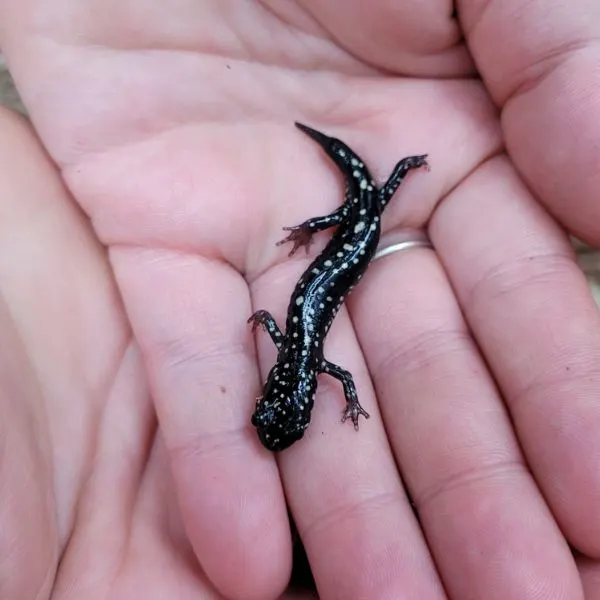
- Binomial Nomenclature: Plethodon glutinosus
- Life Span: 5.5 years on average, 20.1 years maximum
- Population Trend: Stable
- Conservation Statuses: S5 (Secure), Least Concern on IUCN
Plethodon glutinosus complex is endemic to New York to central Florida and south-central Texas. The species is also found as far west as Missouri and eastern Oklahoma.
The species is endemic to wooded slopes, cave entrances, shale banks, floodplains, and ravines. Most often the species are endemic to hardwood forests and to a lesser extent pinelands.
Adults usually hide under logs, rocks, leaf litter, or stumps during the day when the weather is high. When the weather is dry or temperatures are freezing the salamander burrows underground or occupies the burrows created by other animals such as rodents.
The species is an invertivore. It feeds on invertebrates such as snails, insects, earthworms, millipedes, centipedes, spiders, and mites.
The slimy salamander has black skin with whitish speckles. The underside is lighter in coloration than the dorsum. Both the ventrum (underside) and the dorsum (body) are similarly colored.
According to Max Planck Institute for Demographic Research, the average lifespan of the species in captivity is 5.5 years. And according to AnAge, the maximum lifespan in captivity is 20.1 years in captivity.
14. Wehrle’s Salamander
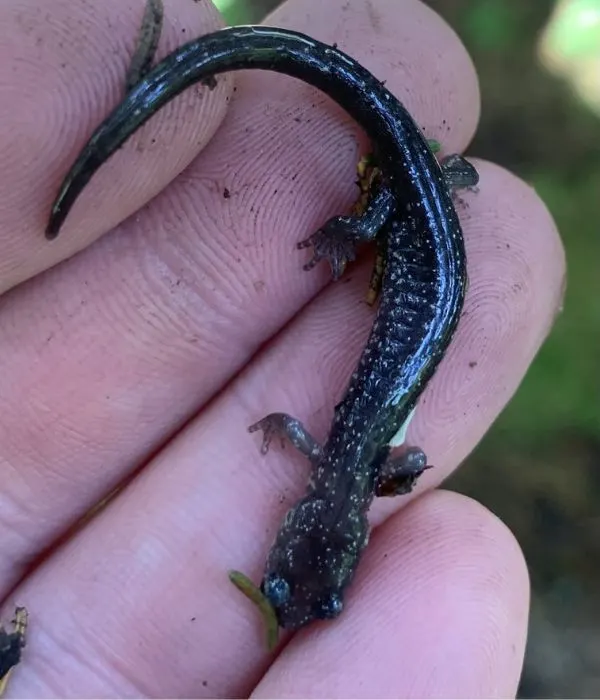
- Binomial Nomenclature: Plethodon wehrlei
- Adult Size: 3.9 to 6.7 inches (10 to 17 cm)
- Population Trend: Stable
- Conservation Statuses: S3 (Vulnerable), Least Concern on IUCN
The species is endemic from southern New York to northern North Carolina. The states in between include Pennsylvania, Ohio, West Virginia, Virginia, and Tennessee.
The geographic range of the species includes the Appalachian Plateau from southwestern New York to southeastern Ohio to the west, and to northwestern North Carolina, and northeastern Tennessee to the south.
This amphibian occupies woodlands and upland forests. The forests they occur in include mixed deciduous and red spruce-yellow birch forests. Within these places, they generally inhabit caves and hide under leaves, logs, rocks, and in crevices.
Considered to be large within its genus – Plethodon. The Wehrle’s salamander can reach a length of 6.9 inches. The species is brown or dark gray with bluish-white, white, or yellow spots on either side of the body.
The lifespan of the species is unknown but it should be around 20 years as other species within the genus such as the slimy salamander.
15. Red Salamander

- Binomial Nomenclature: Pseudotriton ruber
- Adult Length: 4.3 to 7.1 inches (11 to 18 cm)
- Life Span: 20 years in captivity
- Population Trend: Stable
- Conservation Statuses: Least Concern on IUCN, S3S4 (Vulnerable)
The amphibian is endemic to a large portion of eastern North America. While the species may still exist in Ontario, they are most likely exotic and not native. The species’ geographic range within the United States extends from southern New York to the Gulf Coast. Interestingly, this amphibian is absent from most of the Coastal Plain and peninsular Florida.
The species inhabit open areas and woodlands. Here they are found in and around cold clear rocky streams as well as springs. Adults hide under rocks, leaf litter, logs, in crevices, and underground. They also live close to water.
This salamander, like most of the others, is an invertivore. It also feeds on amphibians. The aquatic invertebrates eat aquatic invertebrates while the terrestrial adults feed on terrestrial invertebrates.
This salamander is called the red salamander because of its red color. The dorsum is red with black spots. This red coloration makes the species relatively easy to identify. Pseudotriton ruber can reach a length of 7 inches.
The species can reach a lifespan of about 20 years in captivity. The lifespan of the species in the wild is unknown.
Family Salamandridae
16. Eastern Newt
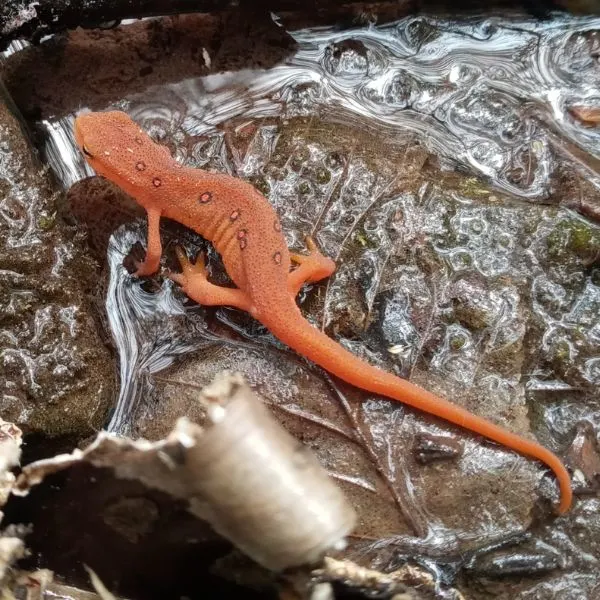
- Binomial Nomenclature: Notophthalmus viridescens
- Adult Length: 2.8 to 4.9 inches (7 to 12.4 cm)
- Life Span: 12 to 15 years
- Population Trend: Stable
- Conservation Statuses: Least Concern on IUCN, S5 (Secure)
This species is endemic to most of eastern North America, from Ontario, Quebec, New Brunswick, and nova scotia to eastern Texas, eastern Kansas, and Minnesota. The species has a stable wild population within New York.
This is an aquatic species when young (in larval form) and semi-aquatic as adults. The adults live in woodlands during the winter but otherwise inhibit pols, streams, swamps, ponds, and lakes. These water bodies must not be home to any predaceous fish.
The larvae have olive skin and feathery gills. The eft is reddish. The adults are yellowish brown to greenish brown.
Family Proteidae
17. Mudpuppy
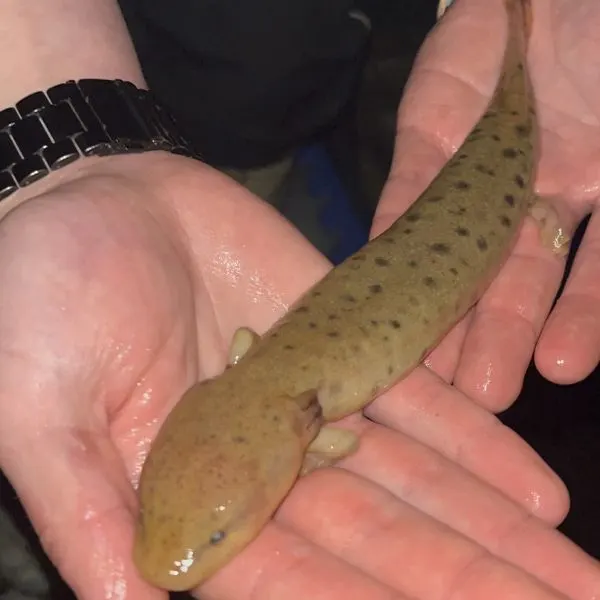
- Binomial Nomenclature: Necturus maculosus
- Average Adult Size: 8 to 13 inches (20 to 33 cm)
- Life Span: 20 years
- Population Trend: Stable
- Conservation Statuses: Least Concern on IUCN Red List, S3S4 (Vulnerable)
The species is endemic to much of eastern North America with the range starting in southern Québec and southeastern Manitoba in the United States to south-central Kansas, central Missouri, southern Illinois, and northern Kentucky. The species is also found in New York, Connecticut, Massachusetts, and Rhode Island.
Family Cryptobranchidae
18. Eastern Hellbender
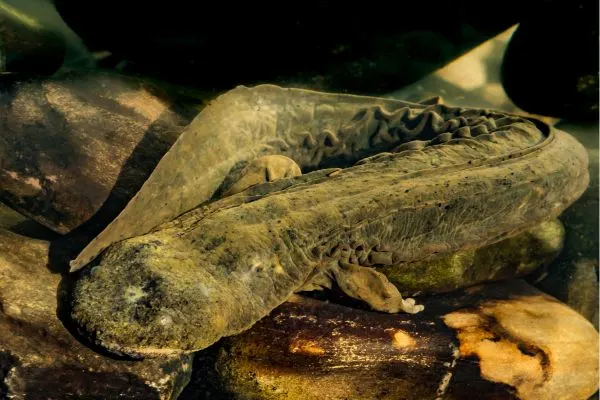
- Scientific Name: Cryptobranchus alleganiensis alleganiensis
- Common Name: Hellbender, hellbender salamander
- Adult Length: 11.6 to 27 inches (30 to 69 cm)
- Life Span: 30 years
- Population Trend: Stable
- Conservation Statuses: Near Threatened on the IUCN Red List, S1 (Critically Imperiled)
In New York, the species is endemic to southwestern and southcentral parts of the state. Sightings are rare and the species is considered to be critically imperiled.
The species is endemic to rivers and rocky clear creeks. They require large shelter rocks. They inhabit cool water below the temperature of 20 degrees Celcius (68 degrees Fahrenheit).
Frequently Asked Questions
Is the blue-spotted salamander in New York?
The blue-spotted salamander is endemic to New York. this salamander can be found throughout the state in the North, South, West, and East.
What are the newts of New York?
There is just one newt endemic to New York and that is the eastern newt. This species is known as the eastern newt as it is endemic to eastern North America. This newt is also known as the red-spotted newt and occurs throughout the state.
Is the hellbender salamander in New York?
The hellbender may be endemic to New York. sightings of this amphibian are few.
Is the red salamander found in New York?
The red salamander is endemic to New York. The species is mostly endemic to southeastern New York.
Is the black salamander endemic to NY?
There are several black salamanders endemic to New York. Some of these include the blue-spotted salamander, the spotted salamander which is black with yellow spots, and the red-backed salamander which may be solid black or grey and may have a red stripe down its back.
Conclusion
There are about 18 salamanders native to the State of New York. Some more popular ones endemic to the state include the hellbender, the mudpuppy, the dusky salamanders, the redback, and the red salamanders.
While most of these salamanders resemble lizards, the mudpuppy resembles an eel. Salamanders may resemble lizards but they aren’t reptiles. Rather, they are amphibians. As amphibians, they may be lungless. Some also have gills. Salamanders start life as larvae. From there they undergo metamorphosis and develop into adults. Some (newts) also have an intermediate stage where they are known as efts.
Some salamanders never undergo metamorphosis and keep their larval form.
Salamanders are interesting creatures and can even be kept as pets. They have delicate skins and as such shouldn’t be handled often. They are also solitary.
Other nearby states
